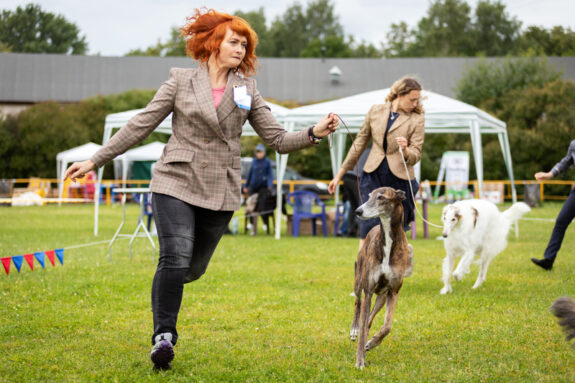
When we asked dog show exhibitors on our Facebook page what they saw handlers doing in a show ring that that could qualify as a “handling pet peeve,” we got 140 answers in a very short amount of time. Some of the responses touched upon the topic of this post, and if you’ve shown your dogs, you’ve probably seen it, too: The handler who has a death grip on their dog’s lead. The leash is so taut, one could almost pluck it and get a B-flat note out of it.
There are any number of reasons why a handler would “string up” their dog on a tight lead, and they include handler inexperience. Ring nerves can make a handler unwittingly tighten their dog’s leash which only telegraphs to the dog that their handler is stressed.
A Whippet column in a 1968 issue of the GAZETTE also admonished never to let the end of a leash dangle from one’s hand as it screams “amateur,” but sometimes those same ring nerves can make a novice forget to roll up the leash’s slack into their hand; when they do remember, they unwittingly tighten the entire leash as they ball up the end of their lead into their hand, but the end result is the same.
A dog’s lack of training can tighten a leash, especially if the dog is a “forge ahead” mover. Professional handlers (and experienced owner handlers) spend a lot of time practicing with their dogs, not only to correct this, but to find the right speed for their dog.
And then there are handlers who know full well what they’re doing, and they “string up” a leash to minimize or hide certain faults on their dog, such as a bad front, lousy pasterns, loaded shoulders, splayed feet or coming out the elbows. Other handlers (as Edward M. Gilbert and Thelma R. Brown point out in their wonderful book, K-9 Structure & Terminology) “string a dog up” to attain a ‘high stepper,’ as is sometimes done in the Poodle ring” (their words, not ours), presumably to make their dog look flashy.
Sadly, a novice may see more experienced handlers doing this and copy it under the belief that it’s what savvy handlers do. Even more unfortunate is that many dogs don’t have faults that warrant a tight leash which ruins a perfectly good dog’s stride because it causes an unnatural gait. Some dogs are on leashes strung up so tightly that their front feet scarcely touch the ground. It not only throws off the dog’s movement, it can make a judge suspicious enough to wonder what fault the handler is hiding, or double down in finding what it is the handler is trying to hide.
We have to commend the writers of breed standards which address the issue by specifically mentioning loose leads in passages of their standard. There are, in fact, eleven breed standards which mention a loose lead:
Cairn Terrier: Should move freely and easily on a loose lead, should not cringe on being handled, should stand up on their toes and show with marked terrier characteristics.
Russell Terrier: Movement must be unrestricted and effortless, while exhibiting an attitude of confidence. The dog must always be exhibited and gaited on a “loose” lead.
Border Collie: When shown, Border Collies should move on a loose lead and at moderate speed, never raced around the ring with the head held high.
The Otterhound should be shown on a loose lead.
In the show ring, the Shiba [Inu] is gaited on a loose lead at a brisk trot.
Judging the Flat-Coat moving freely on a loose lead and standing naturally is more important than judging him posed.
Golden Retriever: It is recommended that dogs be shown on a loose lead to reflect true gait.
The Field Spaniel should be shown at its own natural speed in an endurance trot, preferably on a loose lead, in order to evaluate its movement.
The Sussex Spaniel: The breed should be shown on a loose lead so that its natural gait is evident.
Havanese should be presented at a natural speed on a loose lead to properly assess the characteristic springy gait.
The Siberian Husky’s characteristic gait is smooth and seemingly effortless. He is quick and light on his feet, and when in the show ring should be gaited on a loose lead at a moderately fast trot, exhibiting good reach in the forequarters and good drive in the hindquarters.
From the Pembroke Welsh Corgi’s Illustrated Standard: The dog should be gaited at a moderate trot on a loose lead.
Loose lips may sink ships, but a good dog should always be shown, we think, on a loose lead.
Photo by ©Svetlana Churkina/Dreamtime Photo
